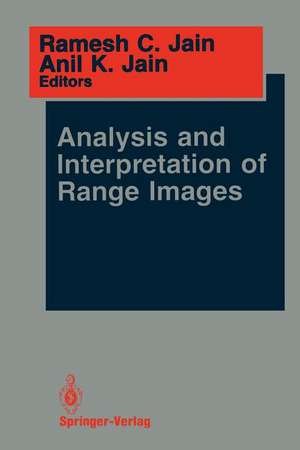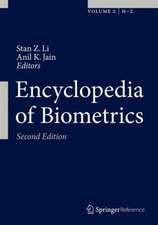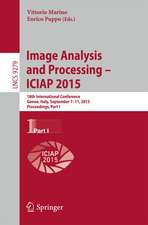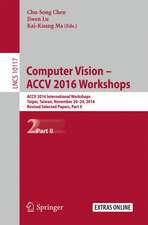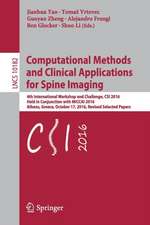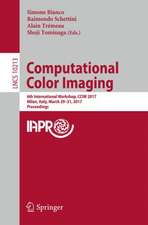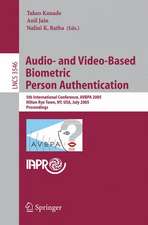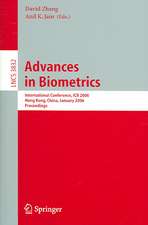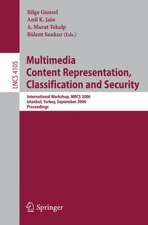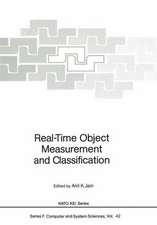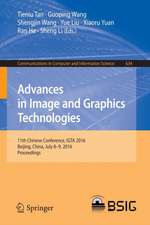Analysis and Interpretation of Range Images: Springer Series in Perception Engineering
Editat de Ramesh C. Jain, Anil K. Jainen Limba Engleză Paperback – 21 sep 2011
Preț: 637.57 lei
Preț vechi: 796.96 lei
-20% Nou
Puncte Express: 956
Preț estimativ în valută:
122.06€ • 126.87$ • 101.20£
122.06€ • 126.87$ • 101.20£
Carte tipărită la comandă
Livrare economică 06-20 februarie 25
Preluare comenzi: 021 569.72.76
Specificații
ISBN-13: 9781461279808
ISBN-10: 1461279801
Pagini: 404
Ilustrații: XIII, 387 p.
Dimensiuni: 155 x 235 x 21 mm
Greutate: 0.56 kg
Ediția:Softcover reprint of the original 1st ed. 1990
Editura: Springer
Colecția Springer
Seria Springer Series in Perception Engineering
Locul publicării:New York, NY, United States
ISBN-10: 1461279801
Pagini: 404
Ilustrații: XIII, 387 p.
Dimensiuni: 155 x 235 x 21 mm
Greutate: 0.56 kg
Ediția:Softcover reprint of the original 1st ed. 1990
Editura: Springer
Colecția Springer
Seria Springer Series in Perception Engineering
Locul publicării:New York, NY, United States
Public țintă
ResearchCuprins
1 Report: 1988 NSF Range Image Understanding Workshop.- 1.1 Introduction.- 1.2 Issues in Sensing and Sensors.- 1.3 Early Processing.- 1.4 Obejct Recognition.- 1.5 Sensor Integration.- 1.6 Range Sensing for Navigation.- 1.7 Applications Group Report.- 1.8 Appendix.- 2 A Rule-Based Approach to Binocular Stereopsis.- 2.1 Introduction..- 2.2 The MPG Approach to Binocular Fusion.- 2.3 Review of Procedures for Stereo Matching Under High-level Constraints.- 2.4 Matching Methods Included in the Rule-based Program.- 2.5 A Review of Some Important Rules.- 2.6 Experimental Results.- 2.7 Conclusions.- 3 Geometric Signal Processing.- 3.1 Introduction.- 3.2 Machine Perception.- 3.3 Geometric Representations.- 3.4 Geometric Sensors.- 3.5 Geometric Signal Modeling.- 3.6 Geometric Descriptions.- 3.7 Geometric Approximation.- 3.8 Robust Approximation.- 3.9 Emerging Themes.- 4 Segmentation versus object representation — are they separable?.- 4.1 Introduction.- 4.2 The Role of Shape Primitives.- 4.3 Segmentation Process.- 4.4 Control Structure.- 4.5 Results.- 4.6 Summary.- 5 Object Recognition.- 5.1 Introduction.- 5.2 Aspects of the Object Recognition Problem.- 5.3 Recognition via Matching Sensed Data to Models.- 5.4 The Statistical Pattern Recognition Approach.- 5.5 Object Represented as Geometric Aggregate.- 5.6 Object as an Articulated Set of Parts.- 5.7 Concluding Discussion.- 6 Applications of Range Image Sensing and Processing.- 6.1 Introduction.- 6.2 Major Industrial Application Areas.- 6.3 Obstacles to Practical Application.- 6.4 Conclusion.- 7 3-D Vision Techniques for Autonomous Vehicles.- 7.1 Introduction.- 7.2 Active range and reflectance sensing.- 7.3 Terrain representations.- 7.4 Combining multiple terrain maps.- 7.5 Combining range and intensity data.- 7.6 Conclusion.- 8Multisensor Fusion for Automatic Scene Interpretation.- 8.1 Introduction.- 8.2 Image Models.- 8.3 Intersensory Verification of Image Features.- 8.4 Intersensory Verification from Physical Principles.- 8.5 Multisensory Vision — An Illustrative Example.- 8.6 Conclusions.
